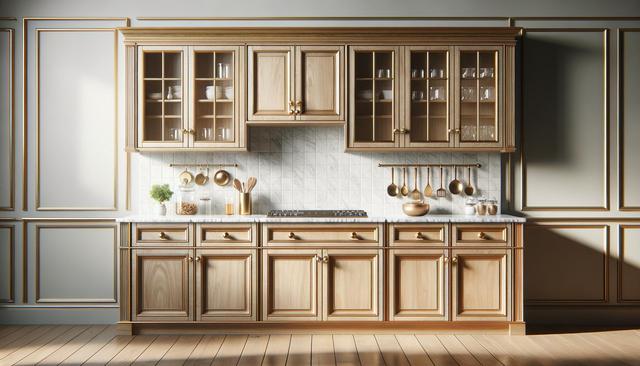Why Color Matters in Kitchen Cabinets
The color of your kitchen cabinets plays a central role in defining the overall atmosphere of your space. While functionality is a key factor, aesthetics cannot be overlooked. The right cabinet color can make a kitchen feel larger, warmer, or more modern, depending on your design goals. From soft neutrals to bold hues, color choices have evolved significantly, offering homeowners more freedom to express their personality through kitchen design.
Color also affects how your kitchen interacts with natural and artificial lighting. Lighter cabinets can reflect light, making a compact kitchen feel more open, while darker tones add depth and sophistication. Understanding how different shades influence mood and space is essential when choosing the right palette. Consider these general effects of popular color families:
- Whites and creams: Clean, bright, and timeless
- Greys and charcoals: Modern, sleek, and versatile
- Blues and greens: Calming, nature-inspired, and stylish
- Dark woods and blacks: Bold, dramatic, and elegant
Each color choice carries its own mood and maintenance considerations. For example, darker cabinets may show dust more easily, while lighter ones might reveal stains or spills. Balancing visual appeal with practicality ensures that your cabinets remain both beautiful and functional.
Popular Kitchen Cabinet Color Trends
Exploring current trends in kitchen cabinet colors can provide inspiration and clarity when updating your space. Today’s designs are moving beyond the classic all-white kitchen to embrace rich, moody hues and nature-inspired tones. These trends not only reflect contemporary style but also support long-term appeal and flexibility in design.
Some of the most notable color directions include:
- Deep navy and forest green: Offering a grounded, luxurious feel
- Two-tone cabinets: Combining light upper cabinets with darker base units for visual contrast
- Matte black: A bold, modern statement that pairs well with metallic hardware
- Warm taupes and greiges: Subtle alternatives to stark white, adding softness and warmth
These color choices can be adapted to various kitchen styles, from minimalist and industrial to rustic and traditional. The key is to find a balance that complements your countertops, flooring, and appliances. Remember that trends evolve, so selecting colors that resonate with your personal taste can help your kitchen remain timeless even as styles shift.
Choosing the Right Finish
In addition to selecting a color, the finish of your kitchen cabinets can dramatically influence their look and feel. Finishes range from high gloss to matte and everything in between. Each offers unique benefits and challenges, depending on your kitchen’s lighting, usage, and maintenance preferences.
Here are some common cabinet finishes and their characteristics:
- Glossy: Reflective and modern, ideal for smaller spaces as they bounce light around
- Matte: Subtle and sophisticated, reducing glare but may show fingerprints
- Satin or semi-gloss: A balanced option that offers low sheen with easier cleaning
- Textured or distressed: Adds character and can hide wear over time
When selecting a finish, consider your lifestyle. Households with young children or high traffic may benefit from finishes that are easier to clean and maintain. Pairing the right finish with a suitable color ensures your cabinets not only look exceptional but also serve your daily needs effectively.
Coordinating Cabinets with Kitchen Elements
Creating a cohesive kitchen design involves more than just picking a cabinet color. It’s about integrating your cabinets with other elements like countertops, backsplashes, flooring, and appliances. Harmony in color and material choices results in a space that feels intentional and well-designed.
To achieve this balance, consider the following tips:
- Choose complementary tones: Warm cabinets work well with warm-toned countertops and flooring
- Use contrast wisely: Pair light cabinets with dark countertops for striking visual interest
- Incorporate texture: Mix smooth cabinet surfaces with textured tiles or wood flooring
- Match hardware finishes: Brushed nickel, brass, or matte black hardware can enhance your color theme
Design tools and samples can help you visualize how different components will work together. Taking the time to plan a unified look helps avoid clashing colors or styles that could date your kitchen prematurely. Think about how your cabinet color will age over time and how easy it will be to update surrounding elements if trends or tastes change.
Making the Right Choice for Your Home
Ultimately, the color you choose for your kitchen cabinets should reflect your individual style while also complementing your home’s overall aesthetic. Whether you’re leaning toward bold colors or subtle neutrals, it’s important to consider how the decision fits with your lifestyle, lighting, and long-term goals for the space.
When selecting cabinet colors, ask yourself:
- Does this color make the space feel inviting and functional?
- Will it coordinate well with existing or planned kitchen elements?
- How will it stand up to daily use and cleaning over time?
- Does it reflect my personal taste and the character of my home?
Many homeowners find it helpful to consult with a kitchen designer or use digital tools to test out color combinations before committing. Investing time into this decision can help you create a kitchen that feels both modern and timeless, with cabinets that truly elevate the heart of your home.
Conclusion: Transforming Your Kitchen Through Color
Exploring the world of kitchen cabinet colors opens the door to exciting design possibilities. By moving beyond outdated tones and embracing modern palettes, you can breathe new life into your kitchen. Whether you’re updating for personal enjoyment or increasing your home’s appeal, choosing a thoughtful cabinet color paired with the right finish and complementary elements can make a lasting impact. Let your kitchen be a reflection of your style—functional, beautiful, and truly yours.




Leave a Reply